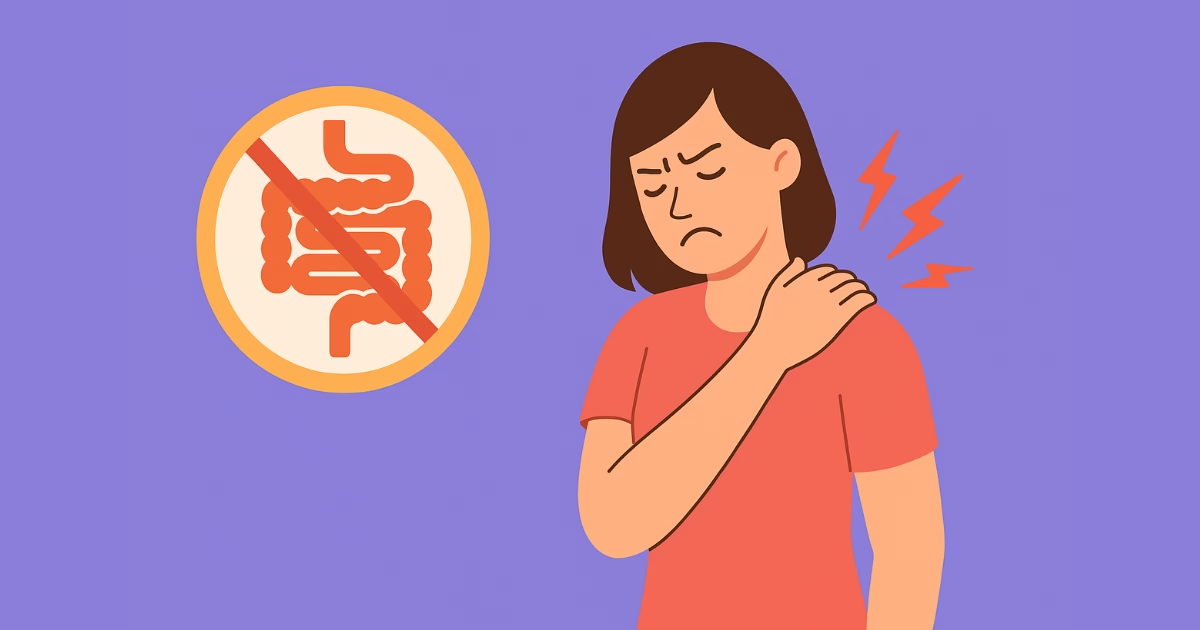Celiac disease is often misunderstood as just a digestive problem. But for many, it affects much more than the gut. One of the lesser-known symptoms is muscle pain—sharp, dull, or even crippling aches that appear without clear reason. These pains can be confusing, especially when they come before a diagnosis. Many people struggle silently, unaware that gluten might be behind their discomfort. That’s why celiac muscle pain stories are so important. They help others realize they aren’t alone. Real-life experiences show the different ways celiac disease shows up in the body—and how painful it can be. This blog explores those stories. From diagnosis delays to recovery through a gluten-free diet, these stories offer insight, support, and a bit of hope. If you’ve felt strange aches or fatigue and never found answers, this might be the connection you’ve missed.
Real Celiac Muscle Pain Stories You Need to Hear
Everyone’s journey with celiac disease is different, but some struggles are surprisingly common. In many celiac muscle pain stories, people describe an aching or cramping sensation that started years before they were diagnosed. Some couldn’t walk without pain in their legs. Others felt constant soreness in their arms, shoulders, or back. For a long time, they were told it was just stress, aging, or even imagined.
Take Emily, for example. She was an active woman in her 30s who suddenly started experiencing sharp muscle spasms. Doctors ruled out fibromyalgia and MS before finally testing her for celiac disease. Within months of going gluten-free, the pain lessened.
Then there’s Mark, who dealt with weakness and cramps in his legs for over five years. His muscle pain faded once he changed his diet and added vitamin supplements. These are just a few voices among many—each one worth listening to.
Why Celiac Disease Causes Muscle Pain
Muscle pain is not the first thing most people think about when they hear “celiac disease.” But it’s real. There are a few reasons why this autoimmune condition can affect the muscles. One major cause is nutrient deficiency. When someone with celiac eats gluten, it damages the small intestine. This damage makes it hard to absorb vitamins and minerals like magnesium, vitamin D, and B12. All of these are crucial for healthy muscles.
Low levels of these nutrients can lead to cramps, spasms, and even long-term weakness. Another reason is inflammation. In people with celiac, gluten triggers an immune response. This reaction doesn’t just target the gut—it can also attack nerves and muscles.
Some people even develop celiac-related neuropathy, which brings numbness, tingling, or burning pain. So, while celiac disease starts in the gut, its effects can spread throughout the body—including the muscles.
Common Patterns Found in Muscle Pain Stories
If you read enough celiac muscle pain stories, patterns begin to appear. A lot of people report having symptoms for years without knowing the cause. Muscle pain is often brushed off. Some doctors misdiagnose it as anxiety, chronic fatigue, or even arthritis. These delays make things worse. The longer gluten is in the system, the more damage it does.
Another common trend is how unpredictable the pain can be. Some feel it only after meals, others wake up with soreness every morning. A few say their pain would shift—from legs one day to shoulders the next.
Interestingly, many people find their pain improves dramatically after switching to a gluten-free diet. Not always right away. Sometimes it takes months. But once the gut starts to heal and nutrients are absorbed better, the muscles begin to recover too. These shared experiences can offer comfort and validation to those still looking for answers.
Gluten-Free Diet and Muscle Pain Relief
A gluten-free diet isn’t just a trend for people with celiac disease—it’s a treatment. Many celiac muscle pain stories include a turning point: the day someone removes gluten and begins to heal. The results aren’t always instant, but they’re powerful.
For some, muscle pain improves within weeks. For others, it takes months of consistent gluten avoidance. The gut needs time to repair, and so does the body. Without gluten, inflammation goes down. Nutrient levels start rising again. This supports the muscles and nerves.
People often add supplements too—vitamin D, magnesium, and B12 are common. But diet comes first. Avoiding even tiny traces of gluten is key. Cross-contamination can bring symptoms back quickly. Most stories include setbacks when gluten sneaks in.
Still, the majority report steady improvement over time. Less pain. More energy. A better quality of life. This change reminds us how powerful food really is.
Expert Opinions on Muscle Pain in Celiac Patients
Experts agree that muscle pain can be part of celiac disease, even if it’s not always in the spotlight. According to Dr. Peter Green, director of the Celiac Disease Center at Columbia University, undiagnosed celiac disease can cause widespread symptoms, including muscle and nerve pain. He says many patients report these symptoms before diagnosis, and they often improve once gluten is removed.
Other specialists highlight the link between malabsorption and muscle weakness. Without proper nutrients, the muscles can’t function properly. Over time, this leads to chronic pain and fatigue.
Some studies also show that gluten can trigger inflammation beyond the gut. This inflammation might affect joints, tendons, or muscles, especially in those who go undiagnosed for years.
The takeaway? If someone has unexplained muscle pain, especially paired with gut issues, it’s worth looking into celiac disease. Experts recommend testing before trying a gluten-free diet.
How to Manage Muscle Pain with Celiac Disease
Living with muscle pain can be draining, but there are ways to manage it—especially once celiac disease is diagnosed. First, going completely gluten-free is non-negotiable. No cheating, no exceptions. Even small amounts of gluten can cause a flare-up.
Second, get tested for nutrient deficiencies. Many people with celiac are low in iron, vitamin D, B12, and magnesium. A doctor can help choose the right supplements.
Stretching and gentle exercise can also help. Yoga, walking, and light weight training can improve circulation and reduce stiffness. But overdoing it might cause more pain, so go slow.
Hydration matters too. Muscles need water to function well, especially when healing. And don’t ignore rest. The body needs time to repair after years of inflammation and damage.
Lastly, join support groups. Other people’s celiac muscle pain stories can provide both advice and encouragement on the rough days.
Emotional Side of Celiac Muscle Pain
The pain isn’t just physical. It takes an emotional toll too. Many people say they felt confused, angry, or hopeless before they got answers. When doctors dismiss symptoms or misdiagnose them, it adds more stress.
Pain makes daily life harder. It interrupts sleep. It affects mood. Some people even say it changed their relationships. It’s hard to explain to others that gluten—not just bread or pasta, but even a crumb—can trigger so much pain.
The good news is that healing isn’t just physical either. Once someone gets diagnosed and starts a gluten-free life, they often feel mentally stronger too. There’s a sense of control again.
Hearing other people’s celiac muscle pain stories helps with this healing. It reminds readers they aren’t alone. Many others have walked this path—and come out stronger on the other side.
Final Thoughts on Celiac Muscle Pain Stories
Celiac disease doesn’t always look the same in everyone. For some, it’s stomach cramps. For others, it’s months—or years—of unexplained muscle pain. These stories matter. They help people recognize symptoms, push for answers, and feel less alone.
If you’ve been dealing with muscle aches that no one can explain, take a closer look. You might find your experience in one of these celiac muscle pain stories. And if you’ve already been diagnosed, your journey could help someone else who’s still searching.
Don’t ignore your pain. Talk to a doctor. Get tested. Go gluten-free if needed. Healing is possible—but it starts with understanding what your body is trying to say.
Your story matters, too
FAQs
1. Can celiac disease cause muscle pain?
Yes. Celiac can lead to nutrient deficiencies and inflammation, both of which may cause muscle pain and weakness.
2. How long does it take for muscle pain to improve on a gluten-free diet?
It varies. Some people feel better in weeks, while others may take months to heal.
3. What nutrients are linked to celiac muscle pain?
Deficiencies in magnesium, vitamin D, and B12 are often linked to muscle pain in people with celiac disease.
4. Is muscle pain a common symptom of celiac?
It’s less common than digestive symptoms, but many celiac patients do report muscle pain, especially if undiagnosed for a long time.
5. Can a gluten-free diet completely stop the muscle pain?
For many, yes. Once the gut heals and nutrients are absorbed properly, the pain often goes away or reduces a lot.

Hi, I’m Shafy Ali – a curious mind and passionate writer at Celiac Magazine. I cover a little bit of everything, from everyday tips and how-tos to deeper dives into topics that spark conversation. I enjoy turning research into readable, relatable content that informs and inspires. Whatever the subject, I aim to keep it clear, engaging, and genuinely useful.

